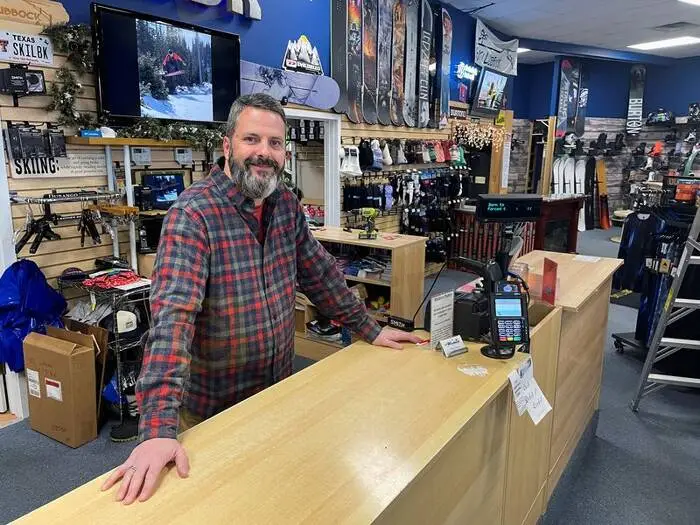简体中文
繁體中文
English
Pусский
日本語
ภาษาไทย
Tiếng Việt
Bahasa Indonesia
Español
हिन्दी
Filippiiniläinen
Français
Deutsch
Português
Türkçe
한국어
العربية
Upside down again’: Omicron surge roils U.S. small businesses
Abstract:By Brad Brooks and Jonathan Allen LUBBOCK, Texas (Reuters) – Phillip Howard pointed toward a stack of black ski pants piled atop a counter in his winter sports shop as evidence of the hurdles small business owners still face as the pandemic drags on.

Phillip Howard pointed toward a stack of black ski pants piled atop a counter in his winter sports shop as evidence of the hurdles small business owners still face as the pandemic drags on.
The pants were supposed to arrive by August at Troys Ski Lubbock shop in west Texas – well before his five-month hot season of selling that kicks off in October. Instead, they came from China the first week of January, delayed by supply-chain failures.
“Late-arriving product really kills us,” Howard said this week, noting that several other items had also arrived late, missing his pre-holiday sales season. “I‘ve been in this business for almost 20 years, and I’ve never encountered anything like this.”
As the pandemic enters its third year, many small businesses across the United States are besieged on three fronts: deepening supply chain issues; periodic staffing shortages; and fewer customers showing up in some areas, fearing the Omicron spike in COVID-19 cases.
This week the Federal Reserve released its latest collection of anecdotes about the state of the economy from businesses, labor groups and others nationwide, showing that the fast-spreading Omicron variant was exacerbating difficulties, especially for hiring and inflation.
U.S. retail sales fell 1.9% in December amid the shortage of goods and surging infections, the Commerce Department said on Friday.
Though federal aid and the economys overall recovery have kept failure and bankruptcy rates for small businesses far lower than expected, day-to-day management has become a challenge. Census surveys conducted since early in the pandemic show concerns steadily shifting from dwindling cash reserves and a hunt for financing to challenges with supply chains and rising costs.
“I‘m placing orders for next year now, and we’re looking at double-digit inflation,” Howard said. “It‘s probably 10% across the board for almost everything that I’m having to order.”
‘UPSIDE DOWN AGAIN’
Staffing shortages forced Gage & Tollner, a 19th-century chop house in Brooklyn, New York, to close for five days in late December.
Co-owner St. John Frizell estimates about 30% of the nearly 60 people working at the restaurant have had COVID-19 in the last month. Owners wanted staff to have a negative coronavirus test before returning to work, but that often meant employees spent hours waiting in lines to get swabbed.
“We just need tests, lots and lot of tests,” he said.
He welcomed the proposal this month by Governor Kathy Hochul that New York should permanently allow restaurants and bars to sell cocktails “to go,” an emergency provision first brought in when establishments were forbidden from seating customers inside in 2020.
Just down the road at Juniors Restaurant and Bakery – renowned for its cheesecakes – owner Alan Rosen said he had suffered with supply chain issues and staffing shortages. He has sometimes had to rope off entire sections of his restaurants when there were not enough servers to go around.
“Our costs of goods are through the roof, theres inflationary pressure, supply chains are a mess,” Rosen said.
Amy Glosser shifted BYKlyn, her cycling studio, to new outdoor premises in the summer of 2020 to keep the Brooklyn business afloat. But Glosser said she and her two dozen employees agreed they could not do another winter outdoors, so she moved the business to a temporary indoor space on Dec. 1.
Then the Omicron variant hit New York City hard, and about 40% of the gyms 200 members said they wanted to cancel or pause their memberships.
“People are nervous to come inside and sweat together,” Glosser said.
Randy Peers, president of the Brooklyn Chamber of Commerce, said he‘s worried about small businesses being evicted after New York state’s pandemic-era evictions moratorium ended on Saturday, noting that about a third of businesses in the Chamber owe back rent.
Peers said optimism grew over the summer and early fall, with the citys high vaccination rates and many restrictions lifted. That lasted through Thanksgiving.
“Then Omicron just threw everything upside down again,” he said.
‘HOLDING OUR BREATH’
Small businesses in states where COVID restrictions have been far looser than New York say customers are still coming out, but other pandemic issues continue to plague them.
Mark Pectol, who owns four Zesty Zzeeks Pizza & Wings shops in the Phoenix metro area, said he never dreamed his biggest nightmare as a small business owner would come in the form of supply chain issues.
“I don‘t know if I’m going to have pizza boxes at the end of the week,” he said. “If I don‘t have pizza boxes – I’m going out of business. Were just holding our breath.”
Even if he can get pizza boxes, Pectol said hes already getting warnings about a possible flour shortage next.
That would be cruelly ironic. In the first year of the pandemic, when grocery stores could not keep flour on shelves, Pectol said he could still buy it in bulk from his supplier. While his stores were closed under pandemic restrictions, he kept money coming in by selling 140,000 pounds of flour to the public.
Now, the fickleness of the supply chain failures may be turning on him.
“My distributor told me they have flour for me for a month. But this week, they didn‘t get any flour in at all,” he said. “If I can’t get it from a big distributor, where will I get it?”

Disclaimer:
The views in this article only represent the author's personal views, and do not constitute investment advice on this platform. This platform does not guarantee the accuracy, completeness and timeliness of the information in the article, and will not be liable for any loss caused by the use of or reliance on the information in the article.
Read more

Top Tips to Avoid Forex Margin Calls and Protect Your Capital
While technical indicators or chart patterns often capture the attention of forex traders, especially new ones, aspects such as margin requirements, equity, used margin, free margin, and margin levels are often overlooked. So, if you have received a margin call from your forex broker and are wondering how to deal with it, you probably do not know the concept of a forex margin call - what triggers it and how to avoid it. Being unaware of this concept can make you lose your hard-earned capital. In this article, we will provide you with all the information you need to know. Keep reading!

Voices of the Golden Insight Award Jury | Peter Karsten, CEO STARTRADER
WikiFX Golden Insight Award uniting industry forces to build a safe and healthy forex ecosystem, driving industry innovation and sustainable development, launches a new feature series — “Voices of the Golden Insight Awards Jury.” Through in-depth conversations with distinguished judges, this series explores the evolving landscape of the forex industry and the shared mission to promote innovation, ethics, and sustainability.

A Guide to Determining the Optimum Forex Leverage
Want to gain a wider forex market position control by investing a minimal amount? Consider using leverage in forex. It implies using borrowed funds to raise your trading position more than your cash balance can let you do it. Forex traders usually employ leverage to churn out profits from relatively small currency pair price changes. However, there is a double-edged sword with leverage since it can multiply profits as well as losses. Therefore, using leverage in the right amount is key for traders. Forex market leverage can be 50:1 to 100:1 or more, which remains significantly greater than the 2: leverage usually offered in equities and 15:1 leverage in futures.

ECN Forex Trading Account Explained: Unlocking Key Details for a Seamless Trading Experience
Seeking forex trading without any third-party involvement? You have an electronic communication network (ECN) by which you can trade through a computerized system that matches buy and sell orders automatically, eliminating the need for a third party. ECN forex trading especially helps investors across different geographies seeking a secure transaction without a third party. With ECN, investors receive privacy, the luxury of automated investing, and the approach to trade beyond normal market hours.
WikiFX Broker
Latest News
Angel one 2025 Review & Complaints
Latest FCA Daily Alerts and Consumer Warnings for 2025
Webull Widens Crypto Futures with Coinbase Derivatives
Is Nash Markets Regulated or Risk? Truth About Nash Markets’ License & Withdrawal Issues
CySEC Blocks Certification Access to Combat Advisor Impersonation
Exclusive Markets Under the Scanner: Traders Report High Swap Charges, Deposit Discrepancies & More
The United States Outgrows All Its Major Peers
PINAKINE Broker India Review 2025: A Complete Guide to Safety and Services
Pinched By Penny Shortage, US Retailers Beg Congress To Step In
PINAKINE Broker Review: A Complete Look at Its Services and Risks
Currency Calculator




